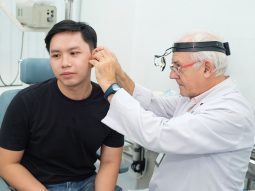Shingles can be cured relatively easily if detected early. However, Dr Nguyen Kim Phuong, Dermatology Department, FV Hospital, says that many cases are treated at a later stage, when patients risk experiencing complications such as prolonged pain, insomnia, and depression for many years.
A patient endures 25 years of pain, discomfort, and insomnia due to late treatment of shingles
Ms N., aged 65, from Singapore, came to FV Hospital for examination and treatment for postherpetic neuralgia, which is pain after shingles. Due to the late diagnosis and treatment of shingles, she had suffered persistent pain for 25 years.
Dr Nguyen Kim Phuong, Dermatology Department at FV Hospital, explains that when Ms N. developed shingles, she overlooked the symptoms of pain, fever, and blistering rash and did not receive adequate treatment.
Initially, because Ms N. was unaware of her condition, she sought medical attention at various healthcare facilities for her various symptoms. She was hospitalised for pain, fever, body aches, and chest heaviness. She also had gastrointestinal examinations to investigate her abdominal and buttock pain, and neurological examinations to diagnose ther headaches. It was only when a rash appeared on her skin that she visited the dermatology department for examination.
While her wounds eventually healed, Ms N. later developed persistent pain and insomnia as a complication and continued to seek treatment from various centres before coming to FV Hospital.

Shingles is a disease caused by the herpes zoster virus which attacks peripheral nerves, resulting in bouts of pain. Those most susceptible to shingles are children, the elderly, individuals with weakened immune systems, and those with compromised immunity. The disease can appear on any part of the body, often affecting the abdomen, neck, shoulders, and back. It can spread when the infected person touches the affected skin and then touches other areas of the body.
Shingles can be treated successfully when detected and treated in its early stages. “The ‘golden’ treatment period is within the first 72 hours of symptoms appearing— during this timeframe, the body typically responds to care and recovers well. If treatment is delayed, it can lead to health depletion; advanced age or underlying conditions can exacerbate the effects and cause nerve-related shingles complications,” explains Dr Phuong.
As the virus attacks nerve roots, various sensations may occur, such as burning pain, scalding pain, prickling pain that feel like insect bites, or sharp stabbing pain. Even mild contact can trigger painful episodes; individuals might experience pain while chewing.
In some cases, the affected skin area may lose sensation and patients are unable to feel the sensation of using a towel to dry the shingles-affected area after bathing.
The reason many patients need treatment for postherpetic neuralgia
Dr Phuong says that five out of every 10 patients that come to FV for shingles treatment suffer from postherpetic neuralgia due to missing the golden 72-hour treatment period.
Shingles can easily be mistaken for other conditions, such as insect bite-induced skin inflammation. Because symptoms are not distinctive, patients do not visit a dermatologist initially but go to see cardiology, gastroenterology, or emergency care doctors. When they eventually they see a specialist in dermatology, the period when shingles can be treated successfully with medication has often already passed.

Another reason many people do not seek appropriate care is because they believe that shingles should be treated using folk remedies. People with shingles do not mention the name of the disease because they believe it will spread and affect their nerves.
“Many rumours make this condition seem mysterious. Patients seek out ‘khoan’ masters, draw talismans, draw ink around the blistered area; some use crushed tobacco as a poultice on the swollen area… These practices increase the risk of skin or blood infections, ulcers, and severe complications, making treatment more difficult.” Adds Dr Phuong.
Shingles is a disease that can be treated with antiviral medications, but if the golden treatment period is missed, patients must be transitioned to pain management treatments.
A collaborative interdisciplinary approach for treating post-herpetic neuralgia.
Dr Nguyen Nam Binh, Pain Clinic at FV Hospital, notes that when blisters have healed but the patient is still experiencing pain, the dermatologist will refer them to the Pain Clinic.
“In cases where patients seek treatment late and are transferred to the Pain Clinic after more than three months of the onset of symptoms, their pain has become chronic. Shingles pain is usually very intense. If it isn’t controlled, it causes changes in the nervous system and the pain will become increasingly severe and difficult to treat. Patients who have been in pain for more than three months usually require additional treatment for depression and anxiety,” explains Dr Nam Binh.
Treatment protocols at the Pain Clinic includes pain-relieving medications in the form of oral medication, patches, and topical ointments. If conventional pain-relief medications are not effective, the doctor may decide to use nerve block techniques which target peripheral and central nervous systems to interrupt the transmission of pain signals to the brain. At FV Hospital, this technique is guided by ultrasound: depending on which areas of skin are painful, the doctor will perform a nerve block on nerve roots using anaesthetic and anti-inflammatory medications.

Dr Binh says that nerve block techniques performed at FVH for pain relief related to shingles have proven effective. A 66-year-old female patient from Dong Nai suffering from severe left arm pain due to shingles came to FV Hospital for treatment in May 2023. Upon admission, her blood pressure was extremely high at 200/122, prompting the immediate decision to perform a nerve block. After the first nerve block, the patient’s pain decreased from an intensity of 8 to 4. A week later, during a follow-up visit, her pain further reduced to an intensity of 1.
Another case involved a 60-year-old woman from Dong Nai who sought treatment at FV Hospital for pain, initially suspecting it to be a side effect of cancer treatment as she experienced it in the same area as her lung, adjacent to the tumour. Further examination revealed that her pain was due to shingles affecting the nerves. Before receiving nerve block treatment, she couldn’t lie down comfortably as the affected area felt hot and painful when in contact with the bed. However, immediately after the first nerve block, she was able to lie down and sleep comfortably.
According to Dr Binh, if a patient continues to experience pain after a nerve block, the next step would be to consider radiofrequency ablation (RFA), a modern, advanced approach that uses heat in the form of high-frequency waves to burn the affected nerves. However, this method has limitations and may not be applicable for certain areas of the body, such as the chest or neck.
For examination and nerve block treatment for shingles, please call the Pain Clinic, FV Hospital at: (028) 54 11 33 33.

 Vi
Vi 












